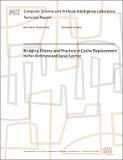| dc.contributor.advisor | Daniel Sanchez | |
| dc.contributor.author | Beckmann, Nathan | en_US |
| dc.contributor.author | Sanchez, Daniel | en_US |
| dc.contributor.other | Computer Architecture | en |
| dc.date.accessioned | 2015-12-21T19:00:15Z | |
| dc.date.available | 2015-12-21T19:00:15Z | |
| dc.date.issued | 2015-12-19 | |
| dc.identifier.uri | http://hdl.handle.net/1721.1/100465 | |
| dc.description.abstract | Much prior work has studied processor cache replacement policies, but a large gap remains between theory and practice. The optimal policy (MIN) requires unobtainable knowledge of the future, and prior theoretically-grounded policies use reference models that do not match real programs. Meanwhile, practical policies are designed empirically. Lacking a strong theoretical foundation, they do not make the best use of the information available to them. This paper bridges theory and practice. We propose that practical policies should replace lines based on their economic value added (EVA), the difference of their expected hits from the average. We use Markov decision processes to show that EVA is optimal under some reasonable simplifications. We present an inexpensive, practical implementation of EVA and evaluate it exhaustively over many cache sizes. EVA outperforms prior practical policies and saves area at iso-performance. These results show that formalizing cache replacement yields practical benefits. | en_US |
| dc.format.extent | 14 p. | en_US |
| dc.relation.ispartofseries | MIT-CSAIL-TR-2015-034 | |
| dc.rights | Creative Commons Attribution 4.0 International | en |
| dc.rights.uri | http://creativecommons.org/licenses/by/4.0/ | |
| dc.title | Bridging Theory and Practice in Cache Replacement | en_US |
| dc.date.updated | 2015-12-21T19:00:15Z | |
